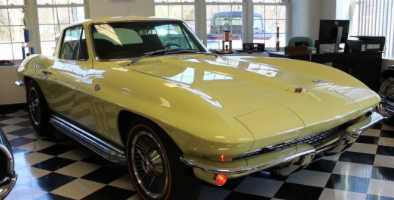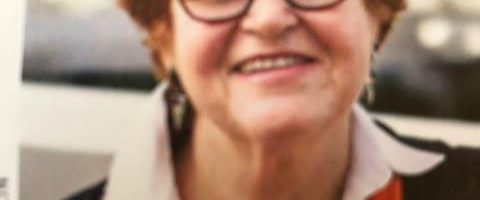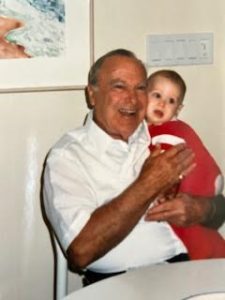Imagine being in that stadium with thousands of other university students and faculty, all roused up, politically aware, wanting a path forward. The emotional energy was contagious and overwhelming. Surely the concerns of so many people coming together could not be denied.
Read More
Corvette

When I worked for ASI in Chicago in 1978, Indiana was my territory. General Motors was a national account, controlled by an account manager who had the relationship with the corporate office in Detroit, but I had several satellite accounts including Delco in Kokomo, an hour north of Indianapolis. My contact person was a mid-level manager named Dick Marshall, on whom I called early in my tenure with the company. He was tall, lanky, fair-haired. I had learned in my recent sales training to set my new contact at ease with the “warm-up”: ask some questions about what he liked to do and perhaps reveal a bit about myself as well.
I quickly learned that he was a classic Corvette aficionado. He collected, restored and showed them. His face lit up as he spoke of them. He invited me to have our next meeting at his home (right next to the plant), so he could show his collection to me. I accepted his offer.
As soon as I got home to my apartment, I called Dan in Boston (my resident car expert; yes, we were a commuting couple for 16 months) and asked him to tell me EVERYTHING about Vettes. There was no “google” 45 years ago. Dan complied and I learned a bit about GM’s finest sports car.
A few weeks later, Dick and I had a business meeting on the couch of his small living room. I instinctively felt I could trust him and that trust was well-placed. His home was not much bigger than the HUGE attached garage he led me to. It housed four cars: a white 1953 Corvette, in pieces all over a tarp, in the process of being restored; two red 1964 Vettes with a white insert, which were his every day, driving-around cars.
And the piece de resistance of his collection: a yellow, 1966 fully restored Sting Ray (like the one in the Featured photo). It was impeccable, PERFECT. You could eat off the engine block. This car, he showed in concourses and shows. It was his pride and joy. I was not allowed to touch it. He didn’t drive it. To transport it, he would put it up on a trailer.
We continued to have an excellent relationship for the nine months that I was in that territory and he signed a small contract with me. But he was up for a promotion that took him to Detroit. Housing costs were different there and he wound up selling off his collection. I think it broke his heart.
I was home in Detroit for Thanksgiving that year with my parents. I went over to my favorite cousin’s later in the evening. Her father, my dad’s oldest brother, had been the assistant comptroller of GM for years, though now long-retired. I told him my company wanted me to make a courtesy call at GM because of my familial connections. The man I was supposed to call on had been hired by Uncle Art (I think his name was Tom, but I’m not sure after 45 years). Uncle Art said it was fine to use his name when making the appointment.
And so, a few weeks later, I did just that, saying that Art Sarason’s niece, Betsy Pfau, would like to call on the gentleman to pay respects from ASI. I stayed with my folks and asked my dad how to get to the Renaissance Center, which was built long after I left the area (this event took place before GPS). Dad’s directions weren’t quite good enough and I was sailing past those towers, still on the highway, and had to figure out how to double back and find my way, but I did get there. I always allowed myself “getting lost” time.
I was shown into Tom’s office. He greeted me brusquely. “What is your relationship to Art Sarason?”, he demanded. I held up my briefcase, which had my monogram ESP embossed in gold letters (a going-away gift from my previous company), “Do you see that ‘S’? It stands for Sarason. Art is my uncle.” Well, the man became a pussycat, asked after my uncle, for whom he had great respect and the meeting went quite well.
After that, I visited Dick Marshall in the same building, just to say hi. He looked ashen, though he was certainly happy to see me. He was so unhappy to be in Detroit, missed his cars terribly (he was driving a Buick LeMans, heaven knows why). We talked about an hour. He felt he had made a big mistake, but there was no turning back. It was clear to me that he had left his heart and soul behind when he sold those Corvettes, even for a big corporate promotion. He had left perfection behind. I never heard from him again.
Malcolm

Malcolm
I never imagined that after decades of friendship we and Malcolm would become estranged, but regrettably it happened.
He and my husband Danny roomed together in college and remained very close. Mal was the most sophisticated one in their crowd – he bought his clothes at Brooks, went to Dunhill’s for his pipe tobacco, and for years rented shares in summer houses in the chic Hamptons.
After college Mal went to Harvard for an MBA, and then worked as a business consultant, eventually running his own firm. He dated many women over the years but never married and lived a peripatetic life, traveling on business a good part of every month while living with his widowed mother in the New York suburbs.
When he was not traveling he’d often meet Danny for lunch and just as often we three would have dinner together. After his mother died we’d invite him to join us for holidays, and when he sold her house I helped him pack for his move to an apartment in the same town.
Then a dozen or so years ago Mal suffered a stroke and could no longer work, and it seemed his life began to spiral down. He’d refuse our invitations and we saw him less and less.
Then one day Mal called to say he could no longer manage on his own, and was moving to an assisted living facility, As he had no family and considered us his closest friends, he asked our help with the move, and hoped we’d find a home for his cat Lily.
Of course we said we would, and arranged to meet him at his place. Over the years we’d seen him at our home or at restaurants, and so when we arrived at Mal’s apartment we were shocked to see that our once fastidious friend had become a hoarder practically living in squalor.
So unexpectedly we found ourselves handling not only the packing and the logistics of his move, but hiring a company to thoroughly clean out the apartment. Mal then told us he owed many months of back rent, and in fact was broke. And so we paid not only his moving and cleanup expenses, but his back rent as well, and found a home for his cat.
But the day we helped Mal move into the assisted living facility was the last time we saw him. He made it clear that our visits would not be welcome, and since then has rebuffed all our overtures, and stopped responding to our calls and emails.
At first I was angry at his seeming ingratitude for all we’d done for him. But I realized of course it was Mal who was angry – at his own helplessness and dependency, and at the loss of the accomplished and active life that had once been his.
And so for all those years of friendship we had shared, I forgave him.
– Dana Susan Lehrman
Adon Olam

My beloved Rabbi Al Axelrad, who was the chaplain at Brandeis when I was an undergrad, retired many years later, but continued to lead High Holiday services until a few years ago. He was a true teacher. His services lasted a long time because he quoted from all sorts of outside texts and I always felt I came away having learned something new.
The last time I saw my father, who died on January 3, 1990, he came into Boston to see his little grandsons and spend Yom Kippur with us. I got him tickets to Rabbi Al’s service and took him over to Brandeis to show him where they were held and where he should park. He came back after the service, truly moved, saying he understood how Al had influenced both his children (my brother became a rabbi in part because of Al’s influence). Dad made a contribution to Hillel at Brandeis in Al’s honor that year. He would only live three more months, but we didn’t know that at the time.
I was decimated by my father’s death (he died of a heart attack, alone in a hospital in Laguna Beach, CA, almost 34 years ago. I still tear up, thinking of him). At services the next autumn, Rabbi Al quoted from an essay from one of his former students: Deborah Lipstadt. She had done her Masters and PhD at Brandeis, overlapped some years with me and been friendly with Al (everyone was). Her essay was called, “The Lord Was His”, and was printed in a collection called “Jewish Reflections on Death”. Al’s quote stuck me, and I spoke to him after the service, asking where it came from. I bought the book and read the essay many times.
Fast forward: Deborah is now a professor at Emory University, a leading authority on antisemitism and the Holocaust. English author David Irving sued her for libel after she called him a Holocaust denier, but she won. The UK libel laws are much more difficult than in the US, so this was a great victory, which she wrote about in “History on Trial”. The case was turned into a movie called “Denial” with Rachel Weisz portraying her.
She was the historical consultant for the establishment of the US Holocaust Museum and, in 2022 was named by President Biden as the US Special Envoy for Monitoring and Combating Antisemitism.
In 2019, Brandeis awarded her an honorary degree and she was the Commencement speaker. My husband and I were at the Fellows Breakfast with all the honorary degree recipients for that day. Our nephew graduated that year and my husband wanted to hurry out and get our seats so we had a good view. I told him I wanted to speak to her and tell her how much her essay had helped me to grieve for my father. I got an eye-roll, but I persisted.
I shyly introduced myself as the sister of Rabbi Richard Sarason (she had heard of my distinguished brother) and long-time friend of Rabbi Al Axelrad. I informed her of that long-ago service where Al had quoted a paragraph from her essay, which made me seek out the entire writing and how much it had helped me, as I read it year after year, trying to seek meaning and solace from my own father’s death.
Her father had left a message to his offspring, which was the point of the essay. A proper German Jewish man who sold monuments, so was involved with death, her father left instructions that the traditional hymn, Adon Olam, be sung at the end of his funeral. That song is only sung at the close of the morning Sabbath service, never at a funeral. She had puzzled about this, then finally focused on the final phrase, which is: “The Lord is with me/I will not fear.” Her father had meant that as his legacy and final message to his children and she understood. We could be sad, lonely, mourn for our loved one, but we were not to fear.
She looked at me with great tenderness. This distinguished scholar and fearless fighter for human rights told me that this essay was the first piece she’d ever had published. It meant so much to her that I took the time to tell her how much the essay meant to me.
Our brief encounter meant the world to each of us.




